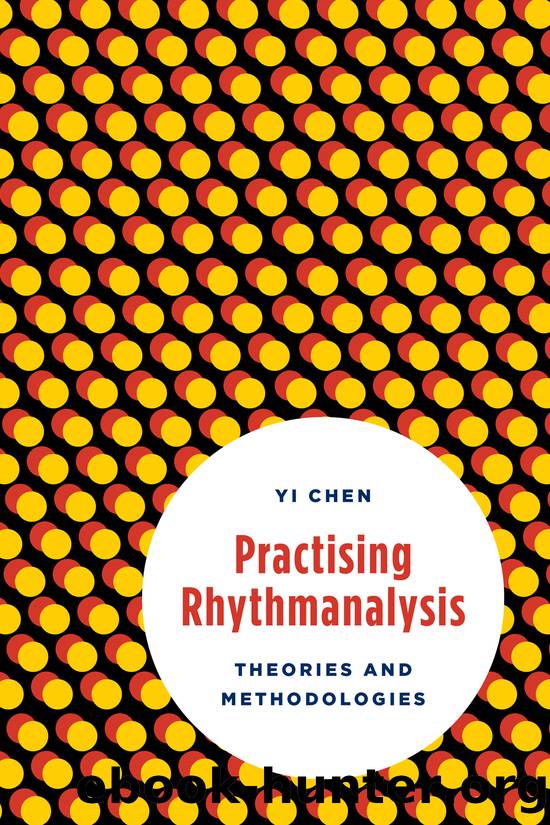Practising Rhythmanalysis by Yi Chen

Author:Yi Chen
Language: eng
Format: epub
Publisher: National Book Network International
Chapter 5
Assembling Postal Rhythms
The Polyrhythmia of Communications
If the previous chapter explores the method of rhythmanalysis in its mode of centripetal investigation â in other words, in terms of how complex and laminated historical movements orchestrate at the site of bodily rhythms â this case study of postal rhythms starts with the aim of weaving the multiplicity of rhythmic structures that bring forth historical experiences. How is the site of communication rhythm conceived of by rhythmanalysis and what are the methodological approaches that instruct the analysis of communication practices? First of all, Lefebvreâs configuration of the concept ârhythmâ needs to be revisited. He asserts that âall rhythms imply the relation of a time to a space, a localised time, or if one prefers, a temporalised spaceâ (Lefebvre 2004, 89). For him, the concept of rhythm is understood as the product of timing-spacing practices which bring the metaphysical division of âtimeâ and âspaceâ into unity. These practices may be recognised through forms of cyclical repetition; for instance, in the collective habits that produce patterns of interrelating social agents and hence create social time-space. In other cases, an approach of following the topological relationships of materialities that enact social rhythms becomes more appropriate. Rhythm, derived from concrete experiences, substitutes the abstract categories of measured âtimeâ (clock and calendar time) and âspaceâ (geographical space) for an experiential account of temporal-spatial relationships. Instead of treating âtimeâ and âspaceâ as a priori categories for analysis, the rhythmanalytical formulation of sites of communication rhythms pays attention to those social phenomena that make time-space in their cyclical and linear forms of repetition (where patterns of social relationships are discernible), or to the ways in which social agents exercise interrelationships (a topological understanding of time-space).
Secondly, sites of communication rhythms consist of social agents (defined by capacities to effectuate interrelationships), which in their ways of forming temporal-spatial alliances orchestrate discernable rhythms. For instance, the regularity and extensiveness of postal communication is dependent upon the constellation of postboxes in rural and urban areas. Postboxes and the array of postal apparatuses in their temporal-spatial arrangements have the agential function of rhythmising postal communication. The siting of the postbox configures spatial arrangements which are closely related to the flow of people and traffic. The number of postboxes, and their proximities to households, shops and collection and delivery points, facilitates interrelating movements and hence a constellation of rhythmic interactions. The methodological presuppositions of rhythmanalysis apropos of the agential function of âthingsâ for making time-space, direct us to those communication objects which are not only delimited by their technological forms (e.g. social media, digital media, TV studies and internet). They suggest creative identifications of communicative âthingsâ (âthingsâ as defined in chapter 2): those communicative assemblages and apparatuses which enact social rhythms. The American scholar Stephen Greenblatt argues that the materiality of any mobility system deserves much observation and analysis. In âa mobility studies manifestoâ, he proposes that we need to look at how things are transferred by examining the âavailable routes, the maps, the vehicles,
Download
This site does not store any files on its server. We only index and link to content provided by other sites. Please contact the content providers to delete copyright contents if any and email us, we'll remove relevant links or contents immediately.
| Administration & Medicine Economics | Allied Health Professions |
| Basic Sciences | Dentistry |
| History | Medical Informatics |
| Medicine | Nursing |
| Pharmacology | Psychology |
| Research | Veterinary Medicine |
Machine Learning at Scale with H2O by Gregory Keys | David Whiting(4179)
Fairy Tale by Stephen King(3220)
Will by Will Smith(2792)
Hooked: A Dark, Contemporary Romance (Never After Series) by Emily McIntire(2500)
Rationality by Steven Pinker(2291)
Friends, Lovers, and the Big Terrible Thing by Matthew Perry(2119)
The Becoming by Nora Roberts(2087)
Love on the Brain by Ali Hazelwood(1965)
HBR's 10 Must Reads 2022 by Harvard Business Review(1777)
The Strength In Our Scars by Bianca Sparacino(1776)
A Short History of War by Jeremy Black(1762)
Leviathan Falls (The Expanse Book 9) by James S. A. Corey(1650)
515945210 by Unknown(1599)
A Game of Thrones (The Illustrated Edition) by George R. R. Martin(1589)
Bewilderment by Richard Powers(1539)
443319537 by Unknown(1470)
The 1619 Project by Unknown(1385)
The Real Anthony Fauci: Bill Gates, Big Pharma, and the Global War on Democracy and Public Health (Childrenâs Health Defense) by Robert F. Kennedy(1366)
Fear No Evil by James Patterson(1278)
